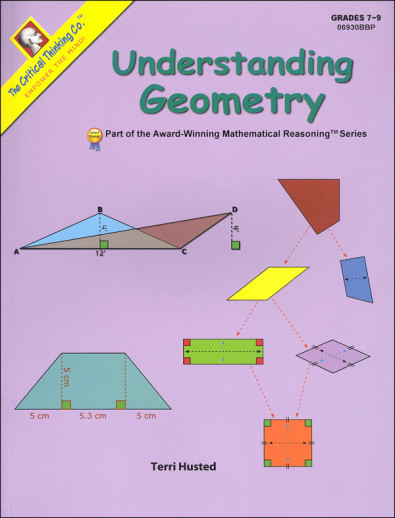We use cookies to make your experience better. To comply with the new e-Privacy directive, we need to ask for your consent to set the cookies. Learn more.
Understanding Geometry (Mathematical Reasoning)
Geometry isn't treated with the intensity in middle school, in many cases, for high school success in the subject. This book follows the National Math Standards and presents an introduction to the basics of geometry. Students won't just learn the properties of geometry, but will learn the reasoning behind the properties and learn the basics of geometric proofs and coordinate geometry. A glossary is included in this 256-page book that can be used as a text in junior high and it is reproducible for family or classroom use. COMPLETE SOLUTIONS ARE AVAILABLE FREE ON THE PUBLISHER WEBSITE.
A glossary of terms that every student should master is included. This book can be used as a classroom textbook in Grades 7, 8, or 9 (usually over a two-year period) or as a reference for high school students. This book covers more than the National Math Standards for middle school mathematics.
This book contains the answers. A free, downloadable Detailed Solutions (PDF) is also available.
Contents
- Geometry Notation
- Lines
- Planes
- Angles—Types and Properties
- Pythagorean Theorem
- Polygons
- Quadrilateral Properties
- Parallelogram Properties
- Perimeter
- Circumference
- Pi
- Trapezoids
- Geometric Constructions
- 3D Shapes—Prism, Cylinders, Pyramids, and Cones
- Symmetry
- Transformations—Reflection, Translations, Rotations, and Dilations
- Tessellations
- Proofs
- Congruency
- Slopes
NOTE: It is our recommendation that students complete Understanding Pre-Algebra before attempting Understanding Geometry
At such an early age, mathematical reasoning begins with simple activities such as distinguishing between even or odd amounts and learning the ordinal numbers. This series is correlated to the NCTM standards and accordingly incorporates topics such as patterns, number concepts/number lines, graphs, fractions, probability, geometry, and problem solving, as well as basic operations. The full color activity sheets should especially appeal to the younger student. Not only are the illustrations eye-catching, but they do an excellent job of demonstrating mathematical representations and relationships. Although manipulatives are not required, a link to a virtual manipulative website is provided in case additional concrete level reinforcement is needed. A wide variety of exercises and activities are utilized to keep your child both interested and motivated. For instance, Thinker Doodles and Mind Benders activities from parent company Critical Thinking are scattered throughout.
Beginning 1 focuses on numbers 1-5 while Beginning 2 focuses on 0-10, and they are intended for use with 3 and 4 year olds. The concepts are presented in a spiral fashion, so students will see the concept repeated at different intervals throughout the book. In most cases, children who finish these first two books should be ready to tackle kindergarten math.
Books A through F are for grades kindergarten through 5th grade, and can be used as core math curriculum. We also like to recommend them as a critical thinking supplement for any math program that is light in that particular area. These books incorporate the same spiral approach found in the Beginning books. Level G has been added for 6th grade and goes beyond drill and practice. It incorporates discussion-based problem solving to prepare students for the reasoning required for upper-level math.
Book 2 of the original series, Mathematical Reasoning Through Verbal Analysis, can be used after the series as a supplement to your math curriculum. A more analytical or math reasoning approach is needed for higher level math and this book will help fill that need. This book can also be used as a reference and resource tool to fill in gaps. Since the book is nicely organized by "strands" (topics), and, additionally, into subtopics, you can easily find problem solving exercises to help repair any deficiency detected or an alternate way of teaching a concept (useful if your child has developed a case of "math block" to understanding a particular concept). Topics cover the entire realm of elementary math: understanding numbers, counting, sequencing, geometry, basic arithmetic operations, measurement, numerical comparisons (greater than, less than, equal to), and tables and graphs. The teacher's manual contains teaching suggestions and the answers. These books are reproducible for family use and range in length from 240-380+ pages.


This looks like a great supplemental geometry review. Our regular textbook did not have a lot of good pictures in it. I think this will be a great year-end review for my son.
Math/ACT tutor suggested this book
Help with understanding the basics.
coop teacher